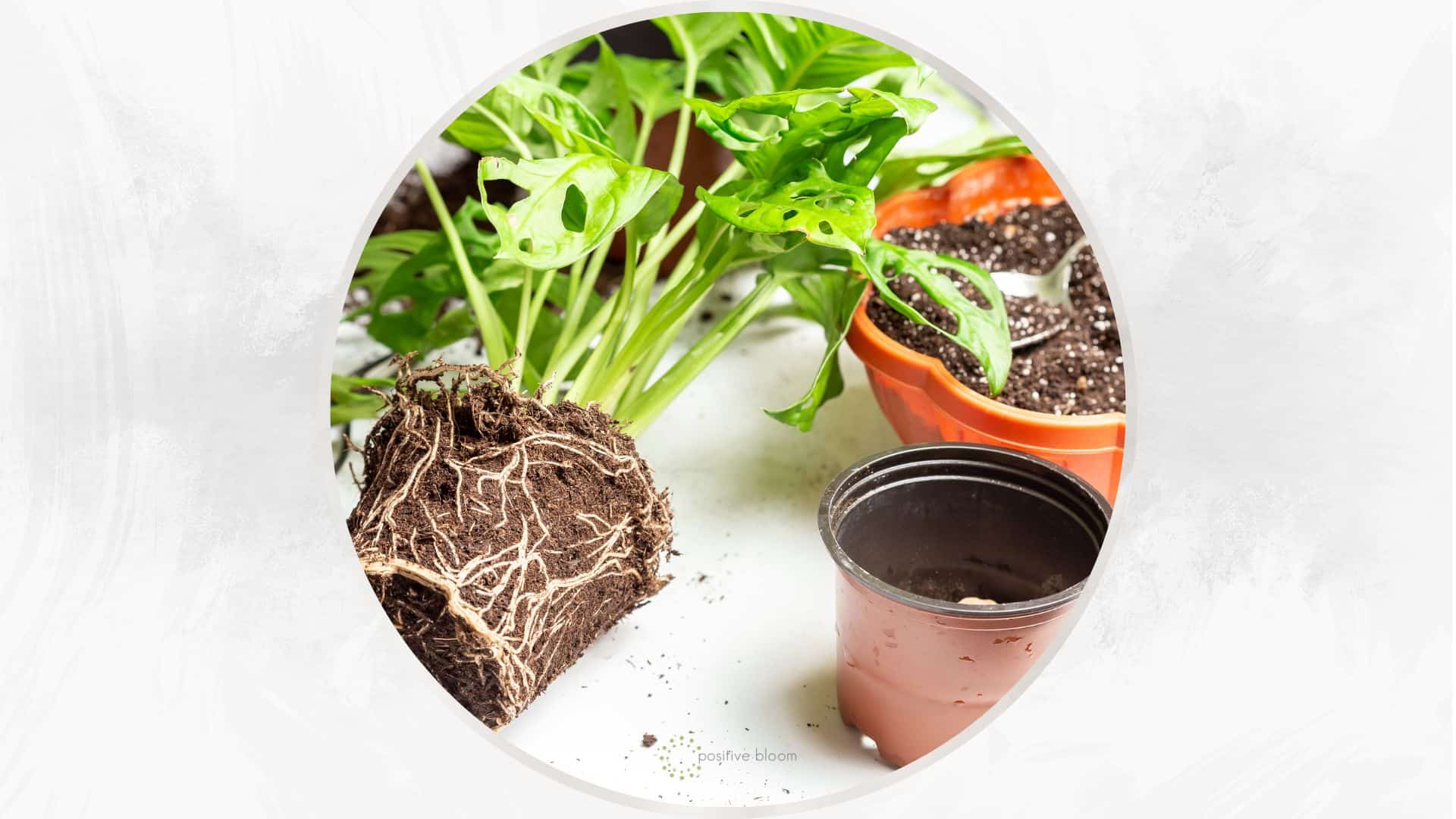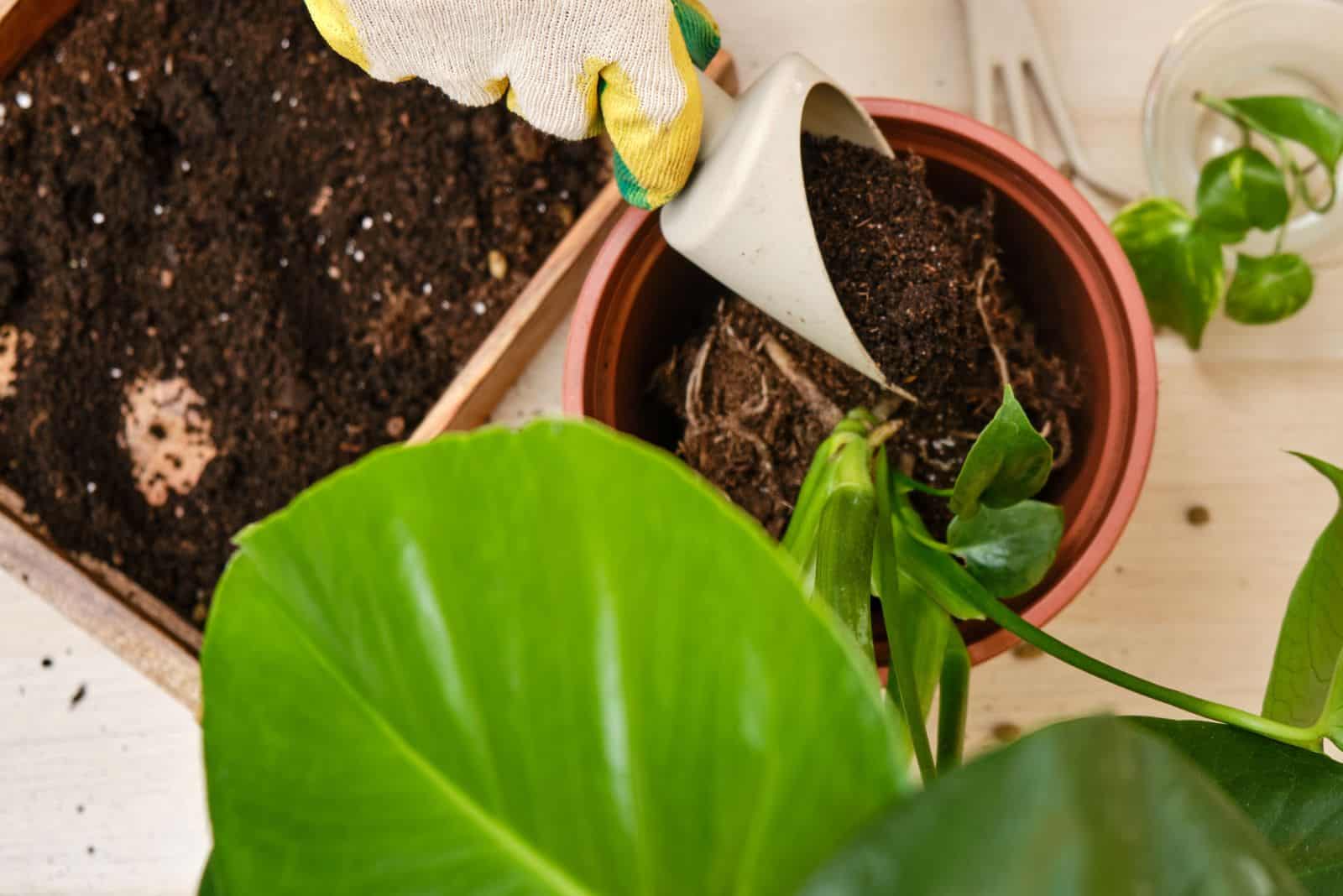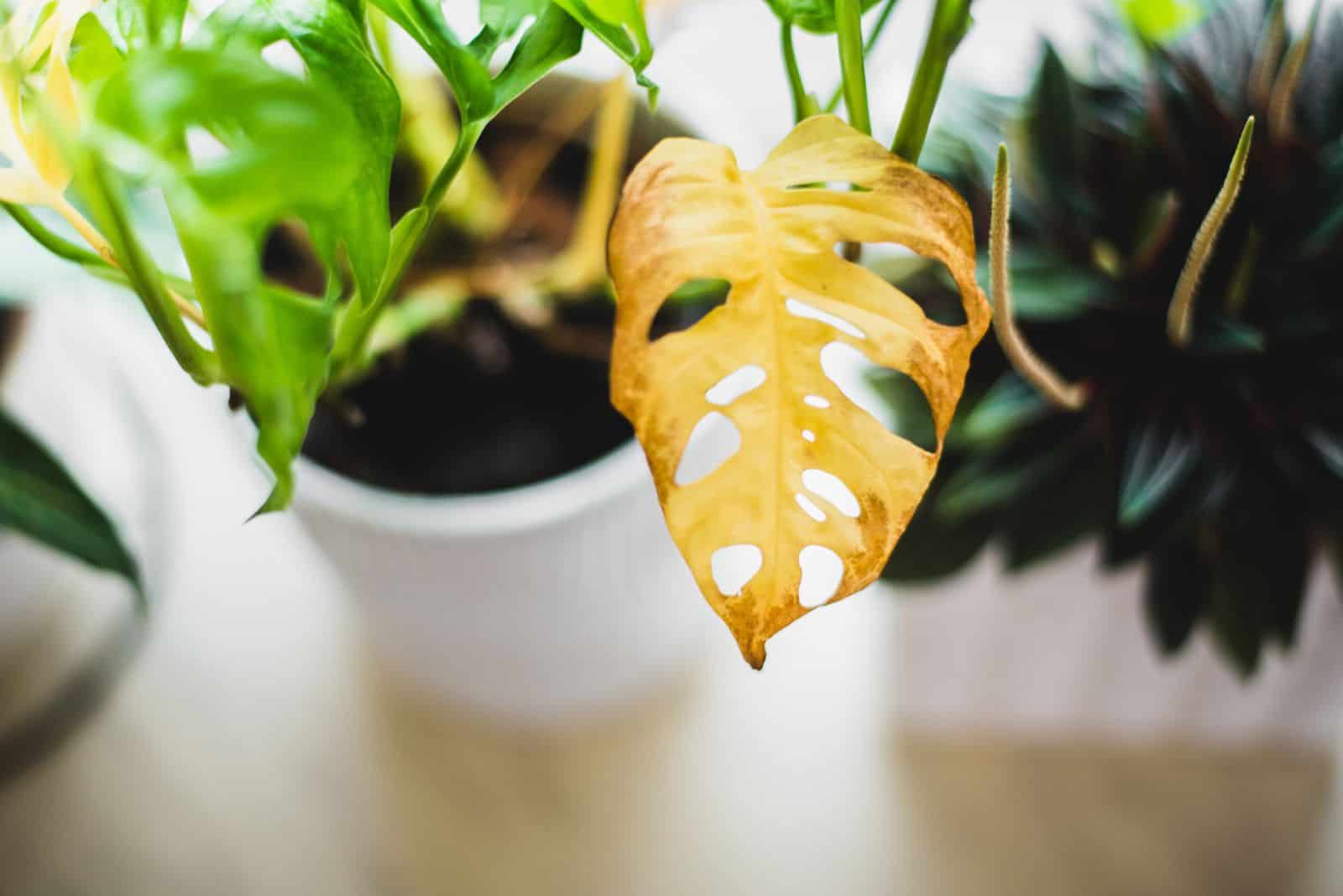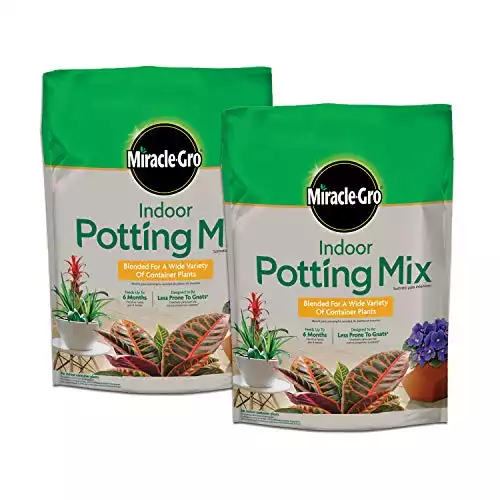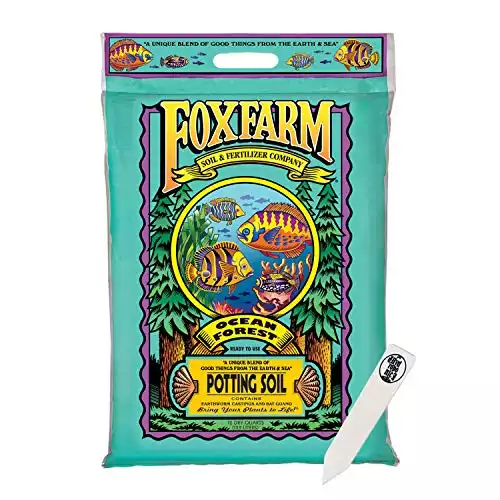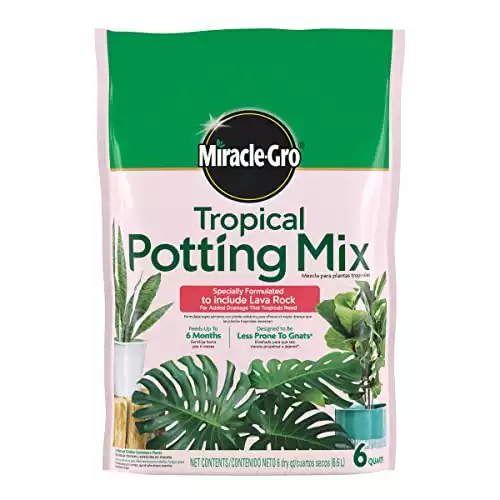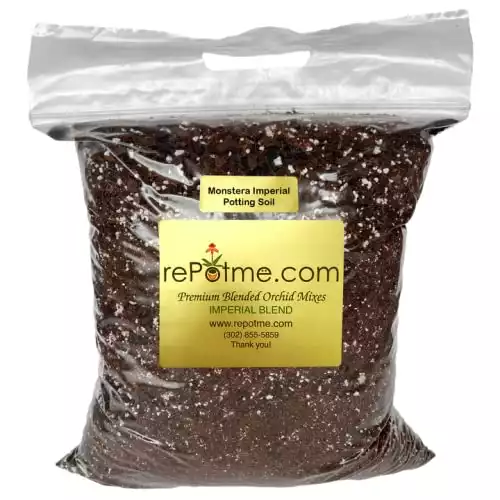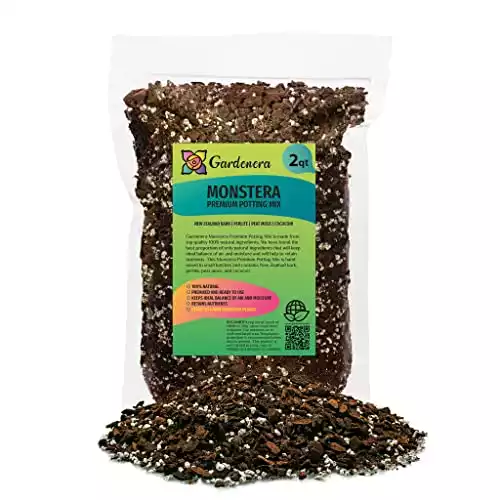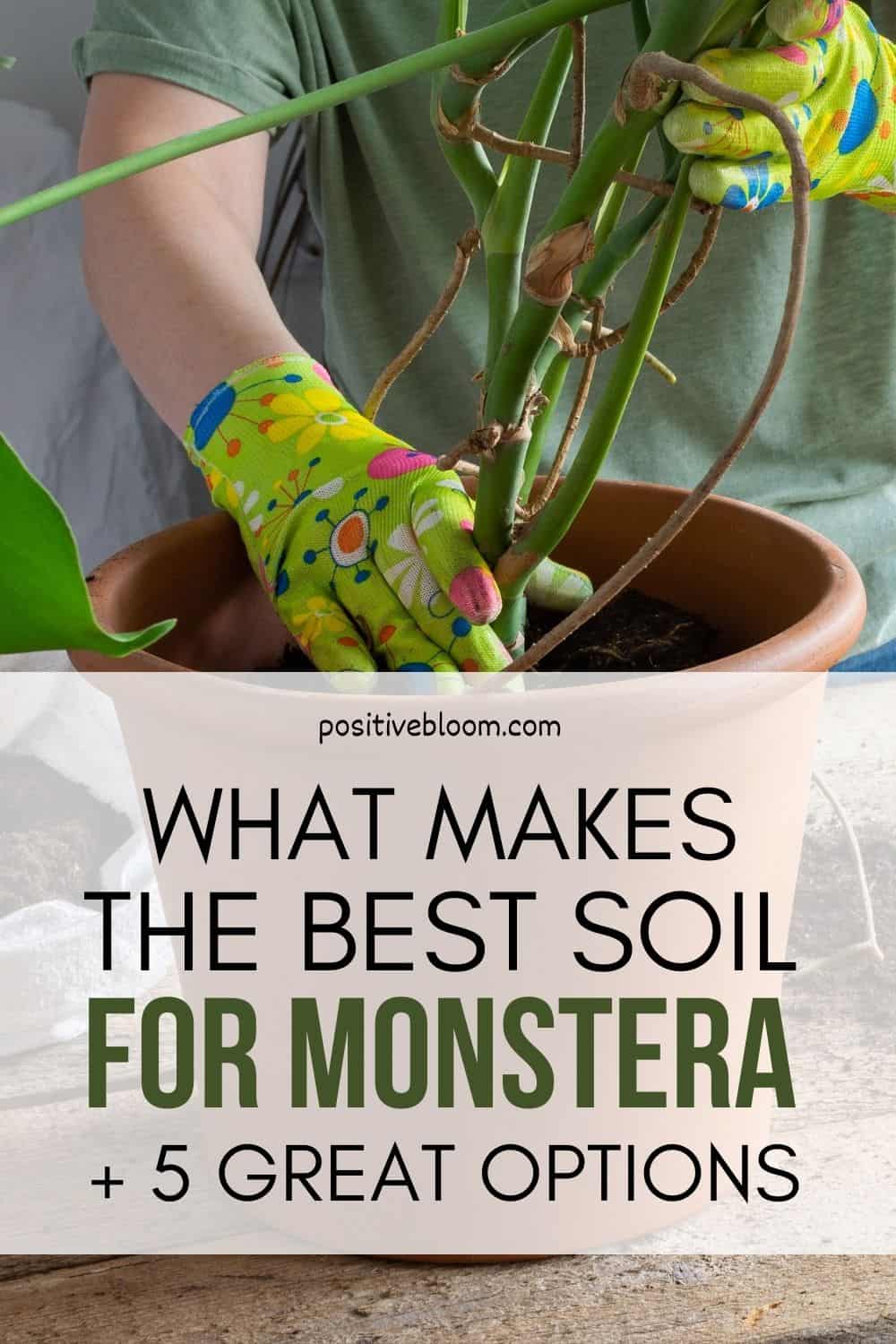Positive Bloom is an Amazon Associate and we earn from qualifying purchases through these links at no extra cost to you.
Monstera plants are some of the most popular houseplants in the world due to their interesting, giant, and fenestrated foliage.
They don’t need too much care, but we should still be careful about the amount of water and sunlight we give them and the type of soil we plant them in.
Today we’ll talk about the best soil for monstera deliciosa, adansonii, and all other varieties.
Generally speaking, the Swiss cheese plant requires well-draining, nutrient-rich soil to meet all its needs.
But how do we get the right measurements? Well, you can buy a ready-made potting mix, or you can continue reading this article and learn what the best soil for monstera is, how to make it, and discover some signs that will tell you if your plant needs a different substrate.
We also included the top 5 products currently on the market, as well as some repotting tips so that you can get your monstera thriving.
Let’s get started!
The Best Soil For Monstera Plants
The best soil for monstera plants needs to be well-draining and rich in organic matter, with a pH level between 5.5-7.0 and moisture-retentive abilities.
All this may seem like a lot, but you can always make an aroid soil mix or go to your local nursery and buy one.
If you want to give your indoor plant the best growing conditions, you should understand its needs perfectly and create an environment it will thrive in.
Potting Mix Drainage And Aeration
Monstera plant roots require good drainage and aeration if you don’t want to deal with overwatering and root rot.
Even though these plants are native to the tropics, the climate there is hot and rainy, which means the soil quickly dries out and also gets hydrated very quickly too.
Growers achieve these conditions by mixing perlite, pumice, pine bark, and other chunky materials. But monsteras require constant soil moisture, so you should also add some moisture-retentive ingredients such as sphagnum peat moss.
Good aeration and water retention need to be balanced to prevent excess water pooling in the pot and keep your monstera hydrated.
Potting Soil pH
Monstera plants flourish in slightly acidic soil with a pH between 5.5-7.0. If you grow this plant in an alkaline medium, it won’t be able to absorb water and nutrients from the soil.
Adding some peat moss to the substrate will keep the soil at the right level.
Although, too much acid in the soil is bad for your plant because that can also lead to toxicity or deficiency of some elements.
For instance, if you plant a monstera in highly acidic soil, it will lack phosphorus, calcium, and magnesium, and also get saturated with aluminum and manganese.
On the other hand, if you grow it in alkaline substrates, you risk boron, zinc, copper, boron, and manganese deficiencies, as well as sodium toxicity.
Therefore, always test the soil pH if you keep your plant in it for a long time, and add some dolomite lime if it’s too acidic or an acidifying agent if it’s alkaline.
Fertility Of The Monstera Soil Mix
The native conditions in which monstera plants developed were extremely rich in organic content, which is why you should provide a lot of nutrients in its growing medium.
They need plenty of minerals to grow their large monstera leaves, so you should get potting soil with plant food in it or mix some fertilizers in if you prefer making your own substrate.
If you don’t use synthetic fertilizers, you can always opt for organic ones and add some worm castings or compost before planting.
The Best Soil Mix Provides Support
Monstera soil needs to provide support. This plant can get massive, and if you plant it in light soil, it can easily fall over.
Another thing you can do to support its healthy growth is to use a moss pole and train it to climb upwards.
The Monstera is a vining plant that climbs using trees, so placing a stake in the soil will make the growing conditions perfect.
Can You Use Cactus Soil For A Monstera?
You shouldn’t use cactus or succulent mixes for monsteras because these blends don’t retain enough moisture.
They drain incredibly fast and will leave your plant parched. If you grow this plant in such a mix, you’ll soon notice signs of an underwatered monstera, such as yellowing or browning of the foliage, no fenestrations, curling, stunted growth, etc.
But if you’ve already bought the mix, you can combine it with regular potting soil instead of perlite or some other draining material to create your personalized monstera blend.
Signs That A Monstera Needs Different Soil
One of the main signs that your monstera is not in the right soil is monstera root rot, which you can recognize by discolored leaves, wet dirt, stunted growth, droopiness, etc.
These symptoms don’t always mean that your plant has gotten this disease, but it will get infected if its roots are constantly wet.
Of course, these symptoms can also indicate other things, and we’ll examine them in the following paragraphs.
Droopiness
Lack of soil moisture is usually the main reason your monstera is drooping. The most common cause of this symptom is infrequent and scarce watering, but inadequate soil can also be a problem.
If the substrate drains too quickly, your plant won’t have enough time to drink what you gave it. Lack of nutrients and inadequate soil pH can also lead to a droopy appearance, so test the soil if you notice this symptom.
Finally, excess water in the soil and too much fertilizer can have the same effect. They can clog the plant’s roots, burn them or make them rot, and cause minerals to build up inside the plant and prevent water and nutrient uptake.
This usually happens if you don’t grow your monstera in well-draining soil or you feed it too often.
Yellow Spots
We hope you never have to ask yourself, ”Why is my monstera turning yellow?” but if you do, know that the most common reasons are under and overwatering.
Of course, inadequate watering is the most common cause, but growing this plant in a medium that’s either too heavy or light can worsen the situation.
Neither an overwatered nor underwatered plant can absorb the moisture and nutrients it needs for healthy growth, so the chlorophyll production slows down, and the leaves lose their beautiful green color.
In order to fix this issue, amend the soil with perlite, sand, and orchid bark if it’s too heavy, or coconut coir and regular soil if it doesn’t retain enough moisture.
Brown Spots
If your monstera exhibits brown spots, it’s likely infected with root rot (or it’s getting too much sunlight).
The leading cause of root rot is overwatering, although it may not develop because you water your plant frequently.
If the soil is too heavy and the pot doesn’t have drainage holes, moisture will remain in the mix for longer and keep the roots wet at all times.
Therefore, to provide your Monstera deliciosa with the best plant care, you should make sure to grow it in a well-draining medium and a terracotta pot with drainage holes.
Make Your Own Soil Mix For A Monstera Deliciosa
To make homemade soil for a monstera, you need to add a balanced ratio of draining and moisture-retentive materials.
Our favorite recipe is mixing equal parts pumice, perlite, coco chips (or coco coir), and orchid bark. Additionally, you can sprinkle some coco peat, vermiculite, and horticultural charcoal and sand over it.
You can also create different mixes and add equal amounts of potting soil and perlite, or you can add some orchid bark and coconut coir to the mixture.
Here is some more info on how to make good monstera soil mix:
We’ll now discuss the roles of different materials in potting mixes for monstera plants.
Add Drainage Materials (Perlite, Vermiculite)
Popular drainage materials for soils are perlite (which resembles styrofoam), pumice (a volcanic rock chunkier than perlite), vermiculite, pine bark, gravel, LECA, horticultural sand, charcoal, etc.
All these ingredients allow the excess water to leave the pot before it can harm your plant.
Vermiculite is good at holding moisture (and LECA balls if you pre-hydrate them), so bear this in mind when creating your own potting mix.
Add Moisture Retention Ingredients (Peat Moss, Coco Coir)
It is equally important to add materials that improve water retention, such as potting soil, compost, peat moss, coco coir, etc.
These ingredients prevent the mix from drying out and keep your monstera just hydrated enough. But if you use too much of these ingredients, you may accidentally create a heavy blend and cause the first signs of an overwatered monstera.
Therefore, make sure to use a balanced amount of draining and moisture-retentive materials for the best mix.
Use Fertilizer
Finally, adding some nutrients to the soil is very important if you want to jump-start your plant’s growth after repotting.
Place some earthworm castings into the growing medium to keep it fertile and aerated, or use organic fertilizers, such as fish or kelp meal, to ensure the healthy growth of your monstera.
However, if you prefer mixing potting soil and perlite to make your own monstera soil blend, you shouldn’t add additional fertilizers.
Store-bought mixes usually come enriched with plant food and can keep your plants well-fed for 3-6 months.
5 Store-Bought Soils That Meet Monstera Needs
Not everyone has the time to make their own plant mixes, which is why buying the right soil has become more and more important.
We found five top products that can help your monstera plants thrive and require little-to-no adaptation.
1. Miracle-Gro Indoor Potting Mix
• Customer review: 4.7/5
• Contains fertilizer
• Less susceptible to gnats
- Feeds plants for up to 6 months
- Loose and easy to use
- Suitable for various indoor potted plants
- Pricey
This lightweight indoor potting mix is a perfect solution for everyone who needs to repot their monsteras.
It doesn’t contain pine bark, which provides shelter to gnats, but it does have other draining materials, such as perlite.
This soil mix from Miracle-gro contains sphagnum peat moss and coco coir, so it’ll retain moisture and keep your monsteras moisturized.
It also has a wetting agent, which improves the initial absorption of water. (And if you’ve accidentally underwatered your monstera, this ingredient will ensure that the soil doesn’t become hydrophobic and that it can soak up moisture.)
This mix is enriched with plant food, which will feed your plants for up to six months, so you won’t have to feed them during that period.
Finally, it comes with repotting instructions, which makes it an excellent choice for beginners.
2. FoxFarm Ocean Forest Potting Soil
• Customer review: 4.7/5
• Adjusted pH at 6.3-6.8
• Light and aerated
- Enriched with organic plant food
- Encourages vegetative growth
- Multipurpose soil
- Pricey
This lightweight and easy-to-use product has everything your monstera plant needs. It contains sphagnum peat moss, sandy loam, and forest products that retain moisture, but is still aerated enough to prevent water clogging.
(And if you want to improve its drainage, you can simply add some perlite or pumice.)
The product is enriched with bat guano, worm castings, crab and fish meal, and other organic fertilizers, so you won’t have to feed your plants any time soon.
The ocean forest potting mix is perfect for monsteras because it has an adjusted pH level between 6.3-6.8 and provides the best absorption of moisture and nutrients.
It encourages the vegetative growth of plants and is perfect for seedlings, container gardening, houseplants, established plants, and trees and shrubs.
Finally, you get the instructions for all these different uses, so you’ll be able to nurture healthy monsteras in no time.
3. Miracle-Gro Tropical Potting Mix
• Customer review: 4.6/5
• Contains fertilizer
• Suitable for indoor and outdoor potted plants
- Provides perfect drainage and moisture-retention
- Feeds plants for up to six months
- Has easy-to-follow instructions
- Pricey
This tropical soil mix is suitable for all aroids, whether you have a monstera, philodendron, or anthurium.
It has good drainage due to the lava rock content and can feed your plants for up to six months after repotting since it contains Miracle-gro plant food.
The mix provides enough support, moisture retention, and aeration to the monstera roots so your plant can thrive.
The unique blend of ingredients makes this potting soil less prone to fungus gnat infestation, so you won’t have to deal with any nasty bugs.
It also has a repotting guide, so it’s one of the best options for beginners who struggle with this.
Finally, the mix may be too moisture-retentive, so either water your monstera plants less frequently or add some perlite to increase drainage.
4. rePotme Monstera Imperial Potting Soil
• Customer review: 4.6/5
• Provides excellent drainage
• High-quality ingredients
- Freshly made
- Comes in resealable bags
- Suitable for various houseplants
- Pricey
This mix is a unique blend of coco coir, vermiculite, stalite, and perlite. All these ingredients ensure necessary drainage, but the first three are also excellent at retaining moisture and nutrients.
The blend is expensive, but it will nurture your plants perfectly.
It comes in a resealable bag, so you won’t have to worry about the mess after using it.
The soil is freshly made and shipped in new batches constantly, so you won’t have to deal with dry, stale, and moldy substrates ever again.
5. Gardenera Monstera Premium Potting Mix
• Customer review: 4.4/5
• Prevents root rot and provides support
• Sterile and non-toxic medium
- Resealable pouch
- Contains biochar, which retains nutrients
- Easy and ready to use
- Pricey
This potting mix has a balanced ratio of bark, perlite, and coco coir, so it provides optimal drainage and aeration to your monstera plants.
It also contains peat moss, worm castings, and biochar, which means it can provide and hold the necessary nutrients long enough for your plants to use them.
Biochar is great at retaining nitrogen, phosphorus, and potassium, providing your monsteras with all the minerals necessary for their growth.
The mix is sterile, so it won’t introduce harmful bacteria or fungi spores to your houseplants.
It also comes in a resealable pouch, which makes it perfect for storing.
The Gardenera monstera premium potting mix is ready to use and suitable for all monstera varieties and other aroids.
Repotting Monstera Plants
Once you’ve explored everything you need to know about the best soil for monstera, it is time to repot it.
Moving this plant to a different container might seem a bit difficult, especially if it’s large and is trained on a moss pole, but we’ve got solutions for everything, including this situation.
The first thing you need to do when repotting this plant is choose an appropriate soil mix, but I think we’ve pretty much covered it. You can always refer to a guide for repotting monstera plants if you need more info, but we’ll mention the most important steps below.
Before we do that, let’s first find out when we should move this plant to a new container in the first place.
When To Repot A Monstera
Monstera deliciosa, adansonii, laniata, or any other variety, doesn’t have a fast growth rate, so you can repot it every 2-3 years.
However, the best indicator that your plant requires repotting are its roots; if you can see them protruding from the drainage holes, it is high time your plant is repotted.
Furthermore, spring is the best time of year to move your monstera to a different planter because it actively grows then and has the best chance to adapt to its new home.
Don’t wait until your plant’s foliage turns yellow or it starts exhibiting symptoms! It’s not the end of the world, but it’s better to prevent those symptoms from occurring in the first place.
How To Repot A Monstera
Step 1. Take the monstera plant out of the pot, remove the dirt around its roots, and wash them until you can see them clearly.
Step 2. Remove any damaged, mushy, and dark roots (if there are any), and spray the rest with a fungicide to prevent further infection.
Step 3. Fill the new, larger pot (or the same one if it’s already the biggest you could find) with a growing medium, place your plant in it, and backfill it with more substrate. (Also put the moss pole in the container if your plant’s attached to it.)
Step 4. Water your monstera until you notice that the moisture has started to come out of the drainage holes. Empty the bottom tray and then put the plant back in its usual spot.
Pro tip: You can remove a monstera from its pot by tipping it to one side and slowly pushing the plant out. Hold the moss pole (if you have it) and ask a friend to keep the pot tilted while you take care of the roots.
Here are some more tips for repotting this plant:
Final Thoughts
The best soil for monstera is a nutrient-rich substrate with excellent drainage and aeration pH between 5.5-7.0 that can support the plant’s healthy growth.
We included some amazing tips for choosing the best growing medium for this plant and revealed some symptoms that indicate your plant might need new soil.
This article also included the best recipes for monstera substrate, whether you simply want to mix potting soil and perlite or try out an advanced method and mix perlite, pumice, coco chips, bark, and other ingredients.
And if you don’t feel like making your own monstera soil mix, you can always choose one from the list we presented.
Finally, we brought some tips and tricks for repotting this plant that will make your life a lot easier.
Good luck, enjoy your healthy monstera, and until next time!
Like this post? Share or pin it for later!

